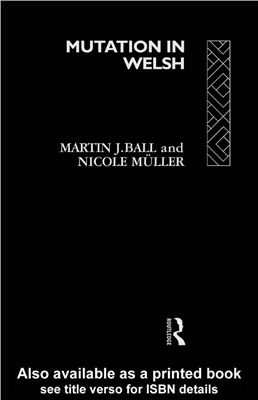Ball M.J. Mutation in Welsh. - Routledge, 1992. - 336p.
The Initial Consonant Mutation system of Welsh is unique to Indo-European languages and has been the subject of much theoretical research. The multi-faceted nature of the phenomenon demands multi-dimensional treatment and this uniquely comprehensive book provides an integrated overview of this important feature from a wide linguistic viewpoint. In Welsh, Initial Consonant Mutation has implications for historical and comparative analyses, phonetic description, phonological theory, syntactic theory, and the interfaces between phonetics and phonology, morphology and phonology, and phonology and syntax. It also requires examination from semantic, psycholinguistic and sociolinguistic perspectives. This study, therefore, brings together a variety of approaches to a wide range of levels of linguistic analysis, all concentrated on one unusual linguistic feature. A detailed review of past research, together with an exploration of recent theoretical advances in many areas, makes this an indispensable book for departments of Celtic Studies and all scholars of comparative linguistics.
The Initial Consonant Mutation system of Welsh is unique to Indo-European languages and has been the subject of much theoretical research. The multi-faceted nature of the phenomenon demands multi-dimensional treatment and this uniquely comprehensive book provides an integrated overview of this important feature from a wide linguistic viewpoint. In Welsh, Initial Consonant Mutation has implications for historical and comparative analyses, phonetic description, phonological theory, syntactic theory, and the interfaces between phonetics and phonology, morphology and phonology, and phonology and syntax. It also requires examination from semantic, psycholinguistic and sociolinguistic perspectives. This study, therefore, brings together a variety of approaches to a wide range of levels of linguistic analysis, all concentrated on one unusual linguistic feature. A detailed review of past research, together with an exploration of recent theoretical advances in many areas, makes this an indispensable book for departments of Celtic Studies and all scholars of comparative linguistics.

